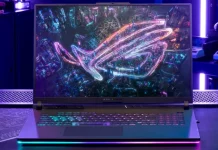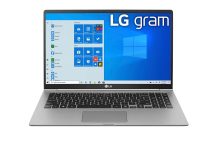You may see the new MacBook Air M1 and think you already know what to expect. It’s not going to be particularly fast, it’ll be overpriced for what you’re getting, and that money will be wasted on a design that rivals already match or exceed. Not only that, but this new MacBook Air is the bottom of the range, so anyone with any sense will go for the MacBook Pro anyway, and there’s certainly nothing here to worry about Windows, Intel, or AMD. In short, it’s a classic example of style over substance.
Except this MacBook Air isn’t. This one has the analysts buzzing. It has hardware vendors looking nervously at their release schedules. It’s shining a bright spotlight on the whole PC industry and platform ecosystem, and much of what you see isn’t pretty. This is a product that marks a new era on almost every front. It doesn’t just ask questions – it provides answers, chiefly in the form of Apple’s all-new M1 chip.
Apple MacBook Air (M1, 2020) review: Specifications
We knew this was coming. Apple announced the shift to the M1 processor back in June 2020: the company was done with Intel CPUs, and would move wholly onto its own chips. This would be an Arm-based system-on-chip (SoC) design, integrating as much as possible onto one piece of silicon, packing a ridiculous number of transistors onto a 5nm die. It wouldn’t just be CPU cores, either – the M1 would include a GPU, memory controller, security controller, interfaces and even system RAM.
But this move from Intel to Arm is a huge gamble. Apple is essentially betting the future of its two-trillion dollar company on it. You might think this an overstatement, given that Apple’s market share of laptops is in the high single digits, but that massively underestimates where M1 sits in the Apple universe. This has to succeed. There’s no going back. M1 must deliver, on every front, in ways that the competitive platforms cannot. And although there’s a grace period during which developers will be frantically moving their apps to support the native M1 platform, this isn’t a multi-year transition. Customers must have workable solutions well before the higher-power version arrives in the spring.
Smart TVs As Low As $99.99. Stream Directly From Your Favorite Services.
What’s so special about the M1? Stripped down to basics, it sounds similar to the chips inside iPhones and iPads. An Arm-based device with eight CPU cores, four of which are the high performance/high power consumption designed for intensive workloads, and four are “efficiency” cores designed for lighter-weight processes. Then there’s a 16-core neural engine that can do 11 trillion operations per second, along with two machine learning (ML) accelerators capable of a trillion operations per second. Graphical kicks come from either seven or eight GPUs, depending on which version you buy.
Add to this either 8GB or 16GB of unified system RAM. This isn’t on the core chip itself but within the same die package. And it’s fully unified, meaning it’s shared between conventional CPU operations and the GPU processes, so data doesn’t have to be copied between two separate RAM systems. This unified design means you can’t buy a MacBook Air with more than 16GB of RAM, but note that the M1 is the first in a new range of processor designs. We fully expect future, higher-power solutions to deliver more cores, more GPU and more RAM.
Apple MacBook Air (M1, 2020) review: Performance
Enough theory: what’s it like to use? In a word, fast. In two, stupidly fast. There’s a level of snappiness that you simply don’t see on other laptops. Open the lid and the desktop is already there. Click on an app icon to start it and it loads – Microsoft Excel takes about one-third of an ‘icon bounce’ to get running. For sheer silliness, we tried loading some 57 apps at the same time – the entire macOS app platform, plus all of Microsoft Office, and Logic and Final Cut Pro, and Blackmagic DaVinci, and a pile of benchmark utilities. It took around 15 seconds.
Smart Speakers And Displays With Google Assistant Starting At $24.99.
This makes it shockingly clear that despite ostensibly the Air not being one of Apple’s professional-grade devices, the Arm CPU core can absolutely handle a professional-grade workload. The unified memory architecture is incredibly rapid too, while the 1TB of disk storage in our MacBook runs to around 3GB/sec of read/write speed. Everything is turned up to 11 on the dial and yet is still designed for minimal power consumption.
The benchmark results speak for themselves. We tested the M1 MacBook Air with 16GB of RAM and compared it against a five-month-old MacBook Pro with an eight-core Core i9 processor and 64GB of RAM, a two-month-old Mac mini with a six-core Core i7 processor and 64GB of RAM, and a 2013 Mac Pro desktop with a Xeon processor and 64GB of RAM, as well as to the M1 MacBook Pro. In all of our tests, the MacBook Air was at the head of the pack, but it was in the Geekbench 5 single-core tests where it really shone, demonstrating a 36.7% lead over the Core i9 MacBook Pro with an astonishing score of 1,724. A result of 7,476 in the multi-core test was similarly stonking, although the gap between it and the rest of Apple’s stable isn’t quite so broad here, with a lead of less than 5% over the i9 Pro.
In short, the M1 is very, very fast. Forget about the Air being Apple’s weediest MacBook – this machine can happily go toe-to-toe with Intel’s best laptop chips, and will crunch through even the most demanding workloads effortlessly.
Apple MacBook Air (M1, 2020) review: Software compatibility
However, all of the CPU and other technical changes will come to nothing if the M1 doesn’t work with the software people want to run. To understand how this will shake out, we need to understand how Apple’s design will work in the developer community. We’ll cover the theory first, then the practice.
The first thing to understand is that the Arm core design of M1 can’t run Intel code by itself. There’s no Intel hardware compatibility here at all. Fortunately, Apple has two hugely important capabilities to hand. First, the developer community. Apple runs a tight ship regarding what can and cannot run on its platforms, whether that’s iOS, iPadOS, or to a lesser extent – macOS. There’s none of the long-term historical support for apps going back several decades that we have on Windows. But if an app for macOS has been written to the latest programming APIs and specifications, creating an M1 ARM version of the app should be relatively simple for the developer.
The phrase “relatively simple” is a moveable feast. You might expect smaller, lightweight apps and tools to move quickly, and that’s certainly the case. Yet even the big boys have their behemoths available in native M1 versions, albeit in early beta and pre-release versions for the moment. That includes Microsoft with the entirety of the Mac Office suite, while Adobe has an early release of Photoshop and Blackmagic Design has an M1 release of DaVinci.
As you’d expect, though, Apple leads the pack. The entire macOS Big Sur platform is native M1, as are its high-power packages such as Final Cut Pro and Logic Pro. To be precise, the M1 version of the app is bundled together into something called a Universal Binary Package, which has both M1 and Intel code within it.
To get around the lack of Intel compatibility, Apple has developed Rosetta 2: a runtime platform that converts Intel x64 code into Arm code on the fly. Apple has history here – Rosetta 1 was part of the transition from PowerPC to Intel 15 years ago. Microsoft has a similar tech for the Windows 10 on Arm platform, again allowing Intel apps to run on the Arm core, but this is still only for 32-bit apps, with 64-bit support coming at some point (hopefully) in 2021.
Apple MacBook Air (M1, 2020) review: x86 emulation
With that theory out of the way, it’s time to consider the effect of the Rosetta 2 emulation layer. Which is… virtually nothing. We simply didn’t notice it in operation. Granted, we can see the performance hit when we look at the benchmarks (around 25%, according to Geekbench 5), but this is to be expected.
The problem is that not all apps work using Rosetta 2. There are apps that clearly hang on by their fingertips to the Apple-Intel platform, and these aren’t well behaved enough to run under Rosetta 2 in a convincing way. Videoconferencing apps, for example, appear to have been designed with the assumption that your device has a nuclear power station strapped to the back, given the way they rampantly consume battery power. Frankly, certain developers need to increase the quality of their code, both on Intel and now on M1.
Although there’s a hypervisor on the platform, Apple has no intention of allowing Rosetta 2 to act as a virtual machine running Windows Intel code. So the same capabilities that you have today on the Intel-based Macs – using a tool such as Parallels to host native Intel-based operating systems like Windows and Linux, for example – is simply not going to work. Microsoft might make a build of Windows 10 on ARM available to run in a hypervisor on the M1, but currently, this is not how Windows on ARM is licensed.
Finally, we should touch on the ability to run iOS/iPadOS apps directly on the M1 processor. Don’t expect all apps to work – some need capabilities such as gyroscopes or GPS, and these aren’t supported on the M1. However, we found that a large portion of our existing library of iOS apps was available to download and run on the M1.
Clearly, developers must do extra work to make sure their apps take full advantage of the platform, but some have done this to great effect already. Others might not want to have their iOS app compete with their higher-priced macOS offerings, and a few might not want to offer an app on macOS at all. Perhaps they want to push users to the web-based experience for better advert monetisation and user tracking – expect to see social media companies resist the iOS-on-macOS capability. Playing Aliens vs. Pinball on the Air has been fun, though.
Apple MacBook Air (M1, 2020) review: Battery
Battery life is both interesting and critically important. Apple claims 15 hours of wireless web browsing and up to 18 hours of Apple TV app movie playback, compared to the 11 hours and 12 hours respectively for the Intel-based MacBook Air. And that’s despite both of the laptops having identical 50Wh batteries.
We first tested this using our standardised video-rundown test, looping a video with the screen set at 170cd/m2 and Flight mode switched on, and it reached a suitably strong 12hrs 15mins. Not the 18 hours Apple claims, so we switched to Apple TV – and hit the same figure. We suspect it would last closer to the claim if we dropped the brightness down, but note that we exceeded Apple’s figures for web browsing: here we got to 17 hours.
This brings us to one of the most significant differences between the new MacBook Air and Apple’s Intel-based Mac mini and MacBook Pro: the silence. No matter what you do on the Intel-based systems, the fans start whirring up almost as soon as your finger goes near the trackpad. The contrast with this new MacBook Air is deafening.
Despite the lack of active cooling, we saw little sign of real throttling, either – the Air maintained its full CPU performance for about ten minutes of maximum workload, and then gracefully declined about 15% over the next 20 minutes. A stark comparison to the poor thermal management and rather choked-off performance of the latest Intel-based MacBook Air.
Apple MacBook Air (M1, 2020) review: Design, display and features
One thing that has remained precisely the same between this MacBook Air and the last iteration is the design. We’d be surprised if you could tell the difference between them just by looking, because we certainly can’t. The only detectable change is the screen, which now offers a wider palette – covering the DCI-P3 colour space rather than sRGB – and, as a result, more punch.
It’s still a 13.3in IPS panel with 2,560 x 1,600 pixels, complete with True Tone technology and a peak brightness of 400cd/m2, and as ever with Apple laptops our technical tests couldn’t pick up any notable flaws. Rivals offer better colour accuracy, with an average Delta E of 1.87 and worst result of 4.49, but overall its colour handling is excellent.
But there are subtle changes, two of which benefit networking: the Thunderbolt 3 USB-C ports are now USB 4 specification and the Air now supports Wi-Fi 6. It had no problem reaching 941Mbits/sec on our 802.11ax-based 10GbE infrastructure Wi-Fi testing rig, and when we plugged in a 10GbE adapter on Thunderbolt that hit the full 10GbE speed.
For those who criticise the lack of a design change, we say “so what”? In fact, we think this is a deliberate choice on Apple’s part. For its customers, M1 must be seen as “the same, only better”: more speed, more battery, more Wi-Fi, a better screen, but with the same look and operation. Given that the motherboard is smaller than the Intel version, Apple may have been tempted to increase battery capacity, but that also adds weight. When you’re already in the high teens for battery life (and somewhat hefty compared to rival ultraportables), it’s questionable whether that’s a good trade-off.
Sadly, the lack of physical changes extends to the 720p front-facing camera. It’s not as bad as some users make out, and the improvements in the video processing on the M1 silicon have definitely helped with how skin tone is handled, but there’s definite room for improvement here.
Apple MacBook Air (M1, 2020) review: Verdict
All of which brings us to the question of whether you should leap in and buy this first-generation M1 hardware or wait for “M2”. There are reasons to wait, especially if you were hoping for a more radical redesign that takes advantage of reduced power demands and no fans. Note the lack of built-in 4G or 5G as well.
However, even with this first-stab device – and even with 16GB of RAM – the M1 has shone a stark, bright light on the whole industry, as well as the expected norms and rules by which it has been run for over a decade. Using this M1 MacBook Air, we have to remind ourselves that this is the low-end product of the new range, and the first version.
If you’re wedded to the Windows and Intel platforms then we understand your reluctance to move, but the combination of the M1 processor and macOS Big Sur makes that platform look stagnant and almost crippling in its backward-looking nature. Even if you’ve never bought a Mac before, the Air deserves your attention.
But what about the MacBook Pro? For us, the Air is the sweet spot. You can come to your own conclusions, but to our mind it doesn’t bring anything significant to the table in the way that it did when Apple was reliant on Intel processors. The lack of fan cooling in the Air isn’t an issue for most users, and we also suspect that the 8GB of RAM in the base model is enough too: our 16GB model performs much more like a conventional Intel-based 32GB product.
Apple made bold claims about its move to M1, and has delivered on every single one of them. It has used its world-class engineering to smash through the glass ceiling for performance of the Arm processor family. The M1 stands comparison with the best that the competition can deliver, Core i9 included, and this is only the beginning. Now can you see why the competition is worried?
Apple MacBook Air (M1, 2020) specifications
| Processor | 8-core 3.2GHz/2.1GHz Apple M1 chip with 8-core GPU |
| RAM | 16GB RAM |
| Graphics adapter | Apple M1 GPU |
| Storage | 1TB M.2 PCIe SSD |
| Screen size (in) | 13.3in |
| Screen resolution | 2,560 x 1,600 |
| Screen type | IPS |
| Touchscreen | N/A |
| Memory card slot | N/A |
| 3.5mm audio jack | |
| Graphics outputs | 2 x USB-C 4 with Thunderbolt 3 support |
| Other ports | 3.5mm headphone jack |
| Web Cam | 720p FaceTime HD webcam |
| Wi-Fi | 2×2 Wi-Fi 6 |
| Bluetooth | Bluetooth 5 |
| Dimensions, mm (WDH) | 304 x 212 x 16.1mm |
| Weight (kg) – with keyboard where applicable | 1.29kg |
| Battery size (Wh) | 49.9Wh battery |
source itpro.co.uk






















